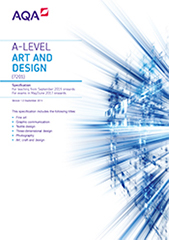3.6 Textile design
Students should be introduced to a variety of experiences that explore a range of textile media, processes and techniques. They should be made aware of both traditional and new media.
Students should explore the use of drawing for different purposes, using a variety of methods and media on a variety of scales. Students should explore the potential for the use of colour. Students may use sketchbooks/workbooks/journals to underpin their work where appropriate.
Students should explore relevant images, artefacts and resources relating to a range of art, craft and design, from the past and from recent times, including European and non-European examples. This should be integral to the investigating and making processes. Students' responses to these examples must be shown through practical and critical activities that demonstrate their understanding of different styles, genres and traditions.
Students should be aware of the four assessment objectives to be demonstrated in the context of the content and skills presented. They should be aware of the importance of process as well as product.
Areas of study
Students are required to work in one or more area(s) of textile design, such as those listed below. They may explore overlapping areas and combinations of areas:
- fashion design
- fashion textiles
- costume design
- digital textiles
- printed and/or dyed fabric and materials
- domestic textiles and wallpaper
- interior design
- constructed textiles
- art textiles
- installed textiles.
Skills and techniques
Students will be expected to demonstrate skills, as defined in Overarching knowledge, understanding and skills, in the context of their chosen area(s) of textile design. Students will be required to demonstrate skills in all of the following:
- awareness of the elements of textile design, such as shape, line, scale, colour, texture, pattern, contrast and/or repetition in relation to the chosen area(s) of textile design
- awareness of intended audience or purpose for their chosen area(s) of textile design
- ability to respond to an issue, concept or idea, working to a brief or answering a need in the chosen area(s) of textile design
- appreciation of the relationship of form and function and, where applicable, the constraints of working to a brief
- understanding of a variety of textile methods, such as: fabric printing, mono-printing, relief printing, screen printing and laser printing; tie-dye and batik; spraying and transfer; fabric construction; stitching, appliqué, patchwork, padding, quilting and embroidery.
Knowledge and understanding
Students must show knowledge and understanding of:
- relevant materials, processes, technologies and resources
- how ideas, feelings and meanings can be conveyed and interpreted in images and artefacts created in the chosen area(s) of textile design
- historical and contemporary developments and different styles and genres
- how images and artefacts relate to social, environmental, cultural and/or ethical contexts, and to the time and place in which they were created
- continuity and change in different styles, genres and traditions relevant to textile design
- a working vocabulary and specialist terminology that is relevant to their chosen area(s) of textile design.
